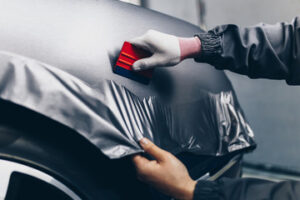A building’s roof protects from rain, snow, wind, and heat. It also reflects solar radiation, helping to keep the interior warm and comfortable.
Roofs are built on a frame of rafters or prefabricated trusses. Wood boards often support the rafters called sheathing, either plywood or oriented strand board (OSB). The sheathing covers the roof’s underlayment. Contact Montana Roofing now!

Plywood is an extremely durable material used in various roofing applications. It is a common choice for sheathing, the base layer that supports and protects shingles and other roofing materials. Plywood is also useful for roofing accessories like skylights and vents. Plywood comes in various thicknesses, ranging from 3/8″ to 3/4″. The exact thickness depends on the roof type and the weight load it will support. It is best to use the same thickness sheathing throughout the roof, rather than mixing thicknesses. Doing so will prevent water from settling in the space between different sheaths.
Plywood can be purchased at most home improvement stores. It is typically sold in 4-by-8-foot sheets. It is made from thin wood strands that are glued together in layers with an alternating grain pattern, which creates a system of checks and balances that helps it resist bending and sagging. It is available in a variety of grades, from A to D. The grade determines the amount of blemishes and knots that it contains. Grades A and B are typically reserved for interior work, while grades C and D can be used in sheathing and roofing.
Builders love plywood for its water resistance, structural stability, and low cost. However, another material, oriented strand board (OSB), is becoming increasingly popular due to its comparable moisture resistance and strength at a lower cost. The specific requirements of a construction project should ultimately dictate which material is best for the job, but OSB may have an advantage in certain situations.
Choosing the right plywood for roofing depends on a number of factors, including the climate in which the building will be located and its expected lifespan. Plywood’s superior moisture resistance makes it a better choice for humid or wet climates, while OSB is better suited to dry climates.
While any plywood is suitable for roofing, it is important to choose exterior-grade plywood that has been treated with a fire retardant substance. It is also important to avoid using plywood that has been cut with power tools, as this can cause the wood to deteriorate faster.
Shingles
Shingles are the most popular roofing material, and they can be used to achieve a variety of aesthetics. Most shingle types protect a roof equally well, and the choice largely comes down to how the homeowner wants their house to look. Some shingles also require more maintenance than others, but it’s possible to cut down on that work with regular inspections and preventive care.
Three-tab shingles, also known as strip shingles, are the most basic and affordable shingle option. They feature a single layer of asphalt and are available in a variety of colors. Architectural shingles, or laminate shingles, are made from two or more layers that can mimic other roofing materials such as cedar or slate. These shingles offer a more polished appearance and are more expensive than strip shingles, but they typically last longer.
Laminated shingles can be used in a variety of color combinations, which gives homeowners a great deal of flexibility when it comes to designing their home’s exterior. These shingles are crafted individually, so each one has its own unique appearance. Many of them also boast a Class 4 impact resistance rating, which can reduce a homeowner’s insurance premium.
Slate shingles are another beautiful and long-lasting option. They can enhance the aesthetic of any style home, and they’re especially suitable for cottages or coastal homes. They’re highly resistant to fire, insects and rot, but they are heavy, so you’ll need to add more structural support to your roof than you would with other materials.
If you choose to go with slate, be sure to hire a skilled roofer to install it for you. It’s a labor-intensive process, and it requires a lot of experience and knowledge to do properly. Slate roofs are also very expensive, but they can last for more than 100 years.
While shingles can be purchased in a wide range of colors, it’s best to stick with lighter shades. Darker shingles absorb the sun’s heat and raise the interior temperature of a home, which can make it more difficult for air conditioners to keep up. If you live in a climate with hot summers, it’s even more important to consider this factor when choosing your shingle color.
Metal
Metal roofing has become increasingly popular for both commercial and residential buildings. It offers a number of benefits such as durability, energy efficiency and aesthetics. However, it also has a few disadvantages including higher initial costs, noise, rust and corrosion, expansion and contraction issues, oil canning and installation difficulties. In order to avoid these problems, it’s important to research the different types of metal and installation techniques before making a final decision.
The primary type of metal used for roofing is steel. It’s available in a variety of alloys and finishes. For instance, copper provides a beautiful traditional appearance while galvanized steel has a more industrial look. Standing seam metal roofs are another popular option for their contemporary aesthetic. Zinc, aluminum and silicon-coated steels are also popular roofing materials. Stainless steel, which has better corrosion resistance than other grades of metal, is also an excellent choice for roofing.
When selecting a metal roof, homeowners should consider the climate of their area as well as their personal preference. For example, metal can withstand strong winds and heavy snowfall, but may not be as effective in wet or coastal climates. It’s also prone to rust if it’s not properly maintained or if it’s exposed to salty air, so homeowners should make regular inspections.
Steel roofs are often made from corrugated galvanized sheet metal. This consists of a wrought iron-steel core wrapped in a layer of zinc and then roll-formed into corrugated panels. There are also hybrid systems that combine metals such as aluminum, zinc and silicon to provide additional benefits. These are known as galvalume, aluminized steel and galvanized-aluminum-zinc.
In addition to varying panel styles, there are also different fastening systems that can be used for metal roofing. Some types of fasteners are hidden while others are exposed, and some types of fasteners are designed to corrode more slowly than others.
It’s important to choose a high-quality product and hire a professional for the installation process. A knowledgeable contractor will ensure that all components are compatible and he will inspect the fasteners to avoid leaks and other problems. It’s also a good idea to check the manufacturer’s warranty in case any problems occur after installation.
Color
Roofing color can add a level of aesthetic appeal that can set your home apart from the rest. However, it can also affect a number of practical considerations. For example, a dark shingle color can absorb heat from the sun and raise your energy costs. A lighter shade can reflect sunlight and keep your house cooler, which may reduce your utility bills. Some local areas even have building codes that require cool roof products.
Shingle colors vary by the brand and manufacturer, as well as the architectural style of your home. For instance, GAF has shingles with warm and cool tones that can complement the colors of brick homes or wood structures. Other manufacturers like Owens Corning offer shingles with more subtle colors that can blend in with almost any home.
Some homeowners choose to paint their shingles a bright color for a bold look, but this could become a problem when it comes time to sell the property. It can make the roof stand out too much and detract from the overall appearance of the house. A more neutral or muted color can be more timeless and may help the home sell quickly and for a higher price.
When selecting a shingle color, take a look around your neighborhood to see how other homeowners are showcasing their homes. Also consider your geographic location and climate. For example, a light-colored shingle will do a better job of reflecting solar energy in the summer than a dark shingle. In addition, darker shingles can hide algae and moisture stains that are common in wet climates.

